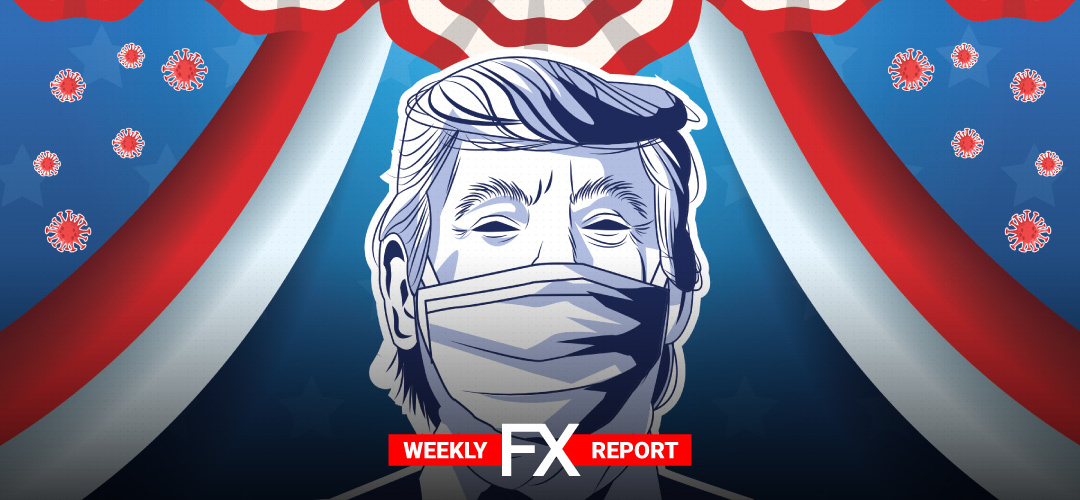On Friday President Donald Trump tested positive for COVID-19, adding another layer of uncertainty just a month before November’s U.S. presidential election.
With President Donald Trump in hospital and a resurgence in cases, it is evident that the recovery is far from complete.
Trump admitted to the hospital for treatment just weeks before the Nov. 3 election. The news about Trump’s contraction of the coronavirus rattled investors, adding to market volatility. That makes the outcome of the vote even more difficult to predict.
The US President has released a series of videos trying to reassure the public that he is recovering. On Monday, Trump made a surprise appearance outside the Walter Reed Medical Center. But his medical status is still unclear, making it difficult for market participants to make a move.
Companies will post their third-quarter numbers soon, with probably another disastrous plunge over last year’s earnings. U.S. job growth slowed sharply in September as the recovery from the COVID-19 slump shifts into a lower gear. Nonfarm Payrolls fell to 661 thousand, down from 1.37 million beforehand.
In Washington, stalemated fiscal aid talks have resumed.
The global economic response last spring was unprecedented as major central banks and governments approved emergency programs. The world’s major central banks will probably not do much more given the aggressive steps they have already take.
On the Brexit front, on Friday, German Chancellor Merkel said she had no breakthrough to announce from EU talks with Britain. But the British Prime Minister and European Commission President agreed on Saturday to step up negotiations on a post-Brexit deal. Johnson said on Sunday he does not want the transition period to end without a new trade deal. However, he believes that Britain could live with such an outcome.
START TRADINGFocus on Trump’s illness, central bank events
With not a lot of major economic indicators released this week, the focus is on Trump’s illness. Investors await several central bank events, which could offer clues about the health of the global economy.
The Federal Reserve and the European Central Bank release minutes from their respective September meetings.
- Investors now look to construction PMI on Tuesday (06.10). Further, on the same day, the focus turns to the Reserve Bank of Australia’s policy meeting and the Australian budget announcement. The RBA has held rates at 0.25% since March.
- The U.S. Federal Reserve’s September meeting minutes are due on Wednesday (07.10). Also, investors await the U.S. Vice Presidential debate on Wednesday.
- The European Central Bank meeting minutes follow on Thursday (08.10). Investors will look to see if policymakers discussed the need for additional flexibility.
- Traders will be looking for August gross domestic product and industrial production on Friday (09.10).
Follow this week’s economic calendar.
LQDFXperts – Trump’s COVID-19 illness adds another layer of uncertainty
EUR/USD reversed directions last week and recorded gains of 0.7%. The pair is trading just above the 1.17 level. The ECB is under pressure to add more stimulus, which would put downward pressure on the euro. With the eurozone economy continuing to struggle, the euro is not particularly attractive to investors.
GBP/USD gained 1.4% last week, recovering the losses of a week earlier. The pound has been volatile in recent weeks, and the strong movement could continue. Sterling investors awaited cues from the final round of Brexit trade negotiations as the end-December expiration of the current transition period approaches.
USD/JPY took a pause from its recent volatility, as the pair showed limited movement last week. The US dollar declined against most of the G-10 currencies last week but managed to gain ground against the Japanese yen.
AUD/USD continues to show strong volatility. The pair gained 1.9% last week, after sliding 3.6% a week earlier. The Australian government, which hands down a federal budget on Tuesday, announced additional wage subsidies to help the labour market. The RBA has hinted that it will lower rates, and if it follows through, the Aussie could lose ground.
USD/CAD dropped 0.5% last week, as the pair closed the week at just above the 1.33 level.
PLEASE NOTE The information above is not investment advice.
Sources: Reuters, CNBC, BBC, The Guardian
